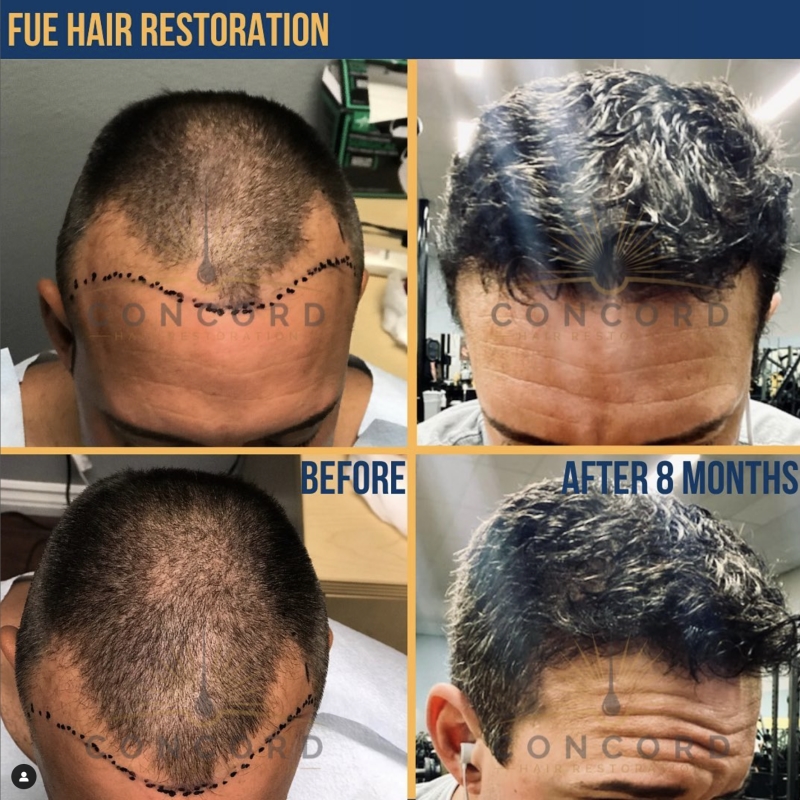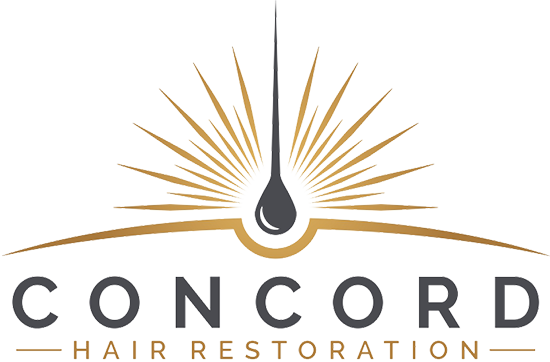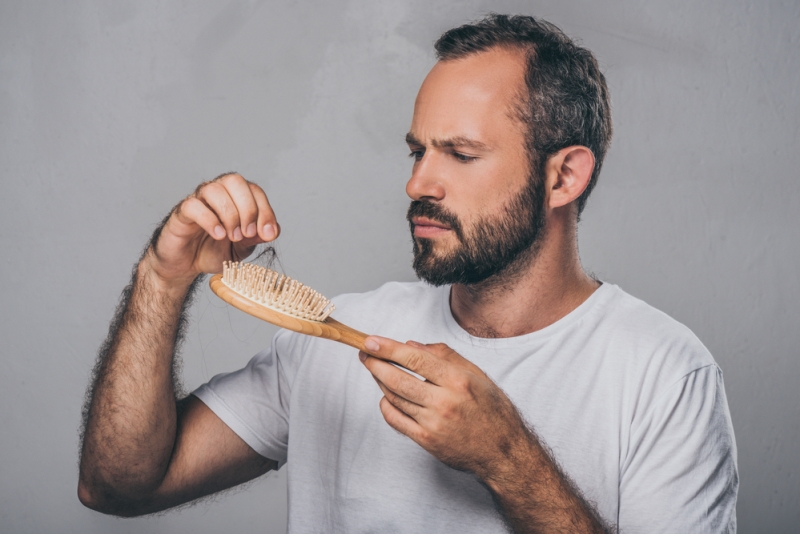Dermatology and Hair Restoration Specialists offer a variety of solutions for those suffering from hair loss. From medication to hair supplements, or hair transplant surgeries we have helped countless patients restore their health by returning its beauty with new growth!
When it comes to hair loss, we usually see 5 different categories of hair loss patients:
No hair loss
There are many people who have a full head of hair. These individuals don’t suffer from any form or rarity in regards to their locks, which means they can largely ignore it when caring for themselves because there will never be anything wrong with what you see!
The v-shaped mane is a genetically programmed trait for many men. This means that no matter what, they will always have some level of hair growth and coverage on their heads even as it gets older with time! But not all hope may be lost if you’re worried about your own thinning or balding; there are treatments available like hair supplements and specific treatments tailored to you we recommend during your free hair consultation.
Welcome to our comprehensive guide on the different categories of hair loss patients. Hair loss is a common issue that affects people worldwide, and understanding its various categories can help individuals identify the underlying causes and find suitable solutions. In this article, we will delve into five distinct categories of hair loss patients, providing valuable insights into each category’s characteristics, possible reasons for hair loss, and effective remedies. Whether you’re experiencing hair loss personally or seeking to expand your knowledge in this domain, this article aims to be your ultimate resource.
1. Androgenetic Alopecia (Male and Female Pattern Baldness)
Androgenetic alopecia, commonly known as male and female pattern baldness, is the most prevalent form of hair loss. Both men and women can experience this condition, but the patterns of hair loss differ between the sexes. In men, it typically starts with a receding hairline and thinning at the crown, eventually leading to partial or complete baldness. In women, it often involves diffuse thinning across the scalp.
Causes: Androgenetic alopecia is primarily influenced by genetics and hormonal factors. The hormone dihydrotestosterone (DHT) is a key player in this condition, as it shortens the hair growth cycle, leading to miniaturization of hair follicles.
Effective Solutions: While it is challenging to reverse genetic factors, there are effective treatments available. Minoxidil and finasteride are FDA-approved medications that can help slow down hair loss and promote regrowth. Hair transplant surgeries and low-level laser therapy are also viable options for restoring hair.
2. Alopecia Areata: Sudden Hair Loss in Patches
Alopecia areata is an autoimmune condition characterized by sudden hair loss in round or oval patches on the scalp, face, or other body parts. In some cases, it can progress to total baldness (alopecia totalis) or even complete loss of body hair (alopecia universalis).
Causes: The exact cause of alopecia areata is not fully understood, but it is believed to result from a combination of genetic predisposition and environmental triggers. Autoimmune reactions against hair follicles lead to hair loss.
Effective Solutions: Treating alopecia areata can be challenging, as there is no definitive cure. However, corticosteroid injections, topical immunotherapy, and minoxidil may help promote hair regrowth in some cases. Wearing wigs or using camouflage products can also provide temporary solutions.
3. Telogen Effluvium: Temporary Hair Shedding
Telogen effluvium is a temporary form of hair loss that occurs when a significant number of hair follicles enter the telogen (resting) phase simultaneously, leading to excessive shedding.
Causes: Telogen effluvium can be triggered by various factors, including physical or emotional stress, hormonal changes (e.g., childbirth, menopause), nutritional deficiencies, major surgeries, or medications.
Effective Solutions: Addressing the underlying cause is essential to treating telogen effluvium. Managing stress, maintaining a balanced diet, and correcting nutritional deficiencies can help hair regrow naturally. Patience is key, as regrowth may take several months.
4. Traction Alopecia: Hair Loss Due to Hairstyles
Traction alopecia is a type of hair loss caused by constant tension and pulling on the hair due to tight hairstyles, such as braids, ponytails, or extensions.
Causes: The repeated pulling on hair follicles weakens them, leading to hair breakage and eventual hair loss. This condition is commonly seen in people who frequently wear tight hairstyles.
Effective Solutions: Preventing traction alopecia involves avoiding tight hairstyles and allowing the hair to rest. If caught early, the condition is reversible. Switching to looser hairstyles and gentle hair care practices can promote regrowth.
5. Medical Conditions and Treatments: Hair Loss as a Side Effect
Various medical conditions and treatments can cause hair loss as a side effect. These include chemotherapy, radiation therapy, thyroid disorders, and more.
Causes: The mechanisms of hair loss in these cases vary. Chemotherapy and radiation target rapidly dividing cells, which include hair follicles, leading to temporary hair loss. Thyroid disorders disrupt hormone levels, affecting hair growth.
Effective Solutions: In cases where hair loss is a side effect of medical treatments, regrowth often occurs once the treatment is completed. For thyroid-related hair loss, managing the underlying condition can lead to improvement. Wigs, scarves, and other hair accessories can provide temporary solutions during treatment.
Conclusion
Understanding the different categories of hair loss patients is crucial for addressing the issue effectively. Whether it’s androgenetic alopecia, alopecia areata, telogen effluvium, traction alopecia, or hair loss due to medical conditions and treatments, each category requires a tailored approach for treatment and management.
If you or someone you know is experiencing hair loss, remember that seeking professional advice from a dermatologist or a trichologist is essential for accurate diagnosis and personalized solutions. Hair loss can have a significant impact on one’s self-esteem, but with the right knowledge and proper care, regaining confidence is possible.
Remember, there is no one-size-fits-all solution to hair loss, and what works for one person may not work for another. Patience, consistency, and professional guidance are the keys to achieving the best possible outcomes.
Although this article is focused on general scalp hair loss and hair restoration to one’s scalp, we also want to mention hair loss in other areas is also included in a free hair consultation. For example, we also provide consultations for facial hair transplants, such as beard transplants, and our famous natural-looking – eyebrow transplants.

Think you’re an ideal candidate? Book your complimentary hair consultation!
Hair transplant surgery is an incredibly personal procedure that should only be done by highly skilled professionals. If you’re looking for the best hair restoration specialist in So Cal, then we can help make sure it happens! Visit Concord Hair Restoration.
Visit us in either of our two locations near you:
San Diego Office
7801 Mission Center Ct.
Suite #105
San Diego, CA 92108
(619) 905-HAIR (4247)
Los Angeles Office
16661 Ventura Blvd.
Suite #824
Encino, CA 91436
(818) 377-5000

